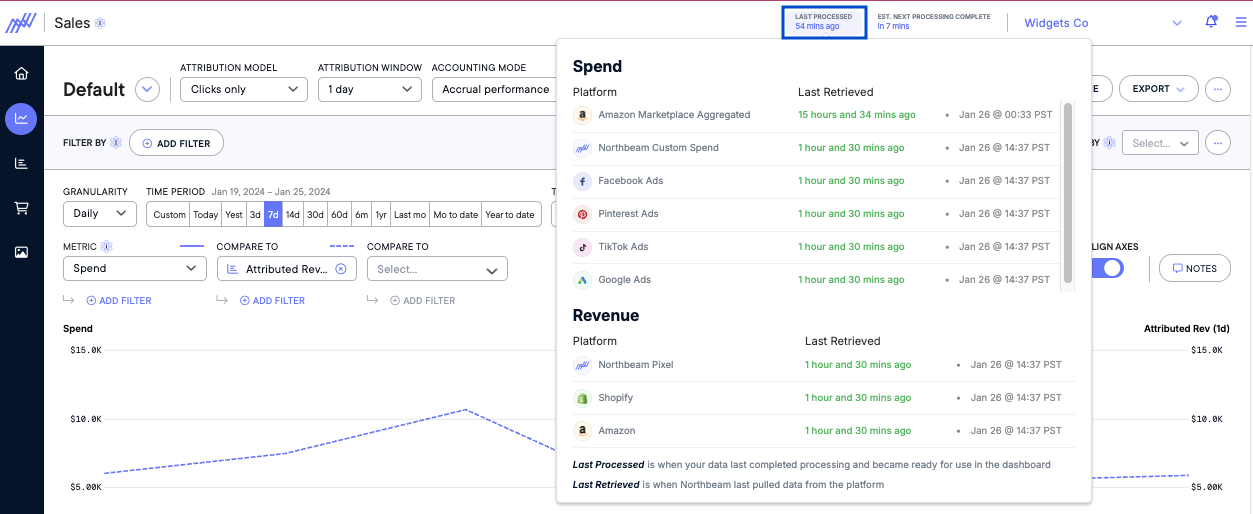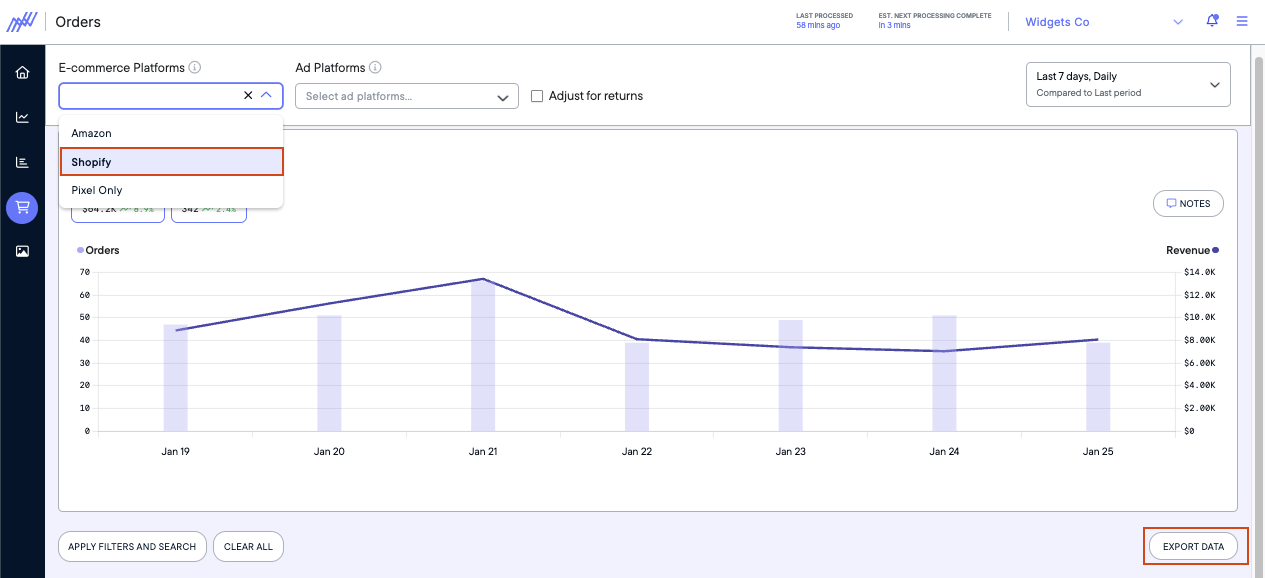Differences in Total Revenue and Orders
When comparing Northbeam's Total Revenue and Orders to your internal source of truth (ex. Shopify Dashboard, internal order dashboard, etc), it's very common to see differences in the data. Use this guide to learn why and about the most common cases.
This guide should answer the following question:
- "Why is my total revenue/orders in Northbeam different than my internal source of truth? (ex. Shopify's reporting)"
Source of Truth | How Revenue is tracked | Notes |
|---|---|---|
Northbeam | Server-Side | Revenue is pulled into Northbeam via API. (Shopify Connection or Server API) |
Shopify | Server-Side | If your Shopify account is connected to Northbeam, our transactions and revenue should match. If it doesn't, please reference the common reasons below. |
Google Analytics | Client-Side | By default, Google Analytics relies on client-side tracking to report revenue. This method can miss conversions in cases where ad blockers, privacy blockers, or VPNs are in use, while server-side tracking can still capture these events. Consequently, the revenue reported by Google Analytics may be lower than that reported by Northbeam. |
My Revenue still isn't lining up. What's going on?Suppose you're comparing Northbeam revenue to a server-side source of truth (ex. Shopify reports), here are a few reasons why you may still see a discrepancy in the numbers:
1. Accounting Mode
Be sure to toggle to the Cash accounting mode, as the default view is on Accrual.
- Cash: revenue is reported on the day the order was placed.
- Accrual: revenue is reported on the day(s) the contributory touchpoint(s) occurred
- Accrual Example: If 3 touchpoints led to a sale, the revenue would be divided across all 3 touchpoints, and each touchpoint may have occurred on different days – resulting in fractional revenue credited to each day.
Learn more about our Accounting Modes.
2. Revenue Calculation
Northbeam calculates revenue differently from other platforms like Shopify. Here’s how they compare:
| Platform | Revenue Calculation |
|---|---|
| Northbeam | Gross Sales + Shipping + Taxes - Discounts |
| Shopify ("Total Sales") | Gross Sales + Shipping + Taxes - Discounts - Refunds |
The key difference is that Northbeam does not deduct refunds by default. This difference can lead to discrepancies. However, you can customize your Northbeam revenue calculation to include any of the following adjustments:
- Deduct Shipping
- Deduct Taxes
- Deduct Refunds
To request a change, submit an inquiry here.
Important to Know:If refunds are deducted, historical revenue data will update when refunds are processed.
For example, if an order is placed on January 1 but refunded on February 1, the revenue for January 1 will change on February 1 to reflect the refund.
3. Refunds
Refunds are not automatically deducted from revenue. However, this setting could be adjusted if needed. Please refer to the “Revenue Formula” above.
Even when refunds are deducted, discrepancies may still arise due to differences in how Northbeam and Shopify handle refunds:
- Northbeam: Because we use Shopify’s API, refunds are tied to the initial order date.
- Example: If an order was placed on January 1st and refunded on February 15th, the refund will be recorded under January 1st, which is the date of the original order.
- Shopify Reports: In Shopify’s standard reports, refunds are tied to the date the refund was processed.
- Example: In the same example above, the refund will be reported on February 15th, the actual day it was processed.
The Refund differences stem from how Shopify’s API handles refunds vs. how their external reports handle refunds. We are actively collaborating with Shopify’s development team to bring these reporting methods into closer alignment for consistency.
4. Platform Filters (Amazon)
If you’ve connected up your Amazon account (Seller Central), those sales are included in your total. Use filters to exclude them if necessary.
How to filter out Amazon Revenue:
- On the Sales page, click Add Filters
- Click on Tile Settings
- Click Add Filters
- Select your filter(s) and click Apply
- On the Overview page, click the 3 dots (...) in any tile
- Click on Tile Settings
- Click Add Filters
- Select your filter(s) and click Apply
5. Timezone
If there's a minor difference, this is oftentimes due to a difference between your Northbeam dashboard's set timezone and your internal order table's timezone.
To see what timezone you're using:
- Navigate to Settings
- Click on Profile
Troubleshooting
If you suspect there's an issue with the connection, let's troubleshoot.
Step 1: Check your Connection
Hover your cursor over Last Processed to identify any broken connections. Under Revenue, you'll see the connections for your revenue sources - specifically Shopify or Custom (S2S) . A broken connection would display a red error message.

Step 2: Compare Northbeam Orders to your Internal Orders
If the Connections are fine, the next step would be to compare Northbeam Orders to your orders to identify any missing orders, extra orders, or orders with revenue discrepancies.
To export your orders in our system:
- In the column on the left-side, navigate to Orders
- Filter for E-Commerce Platform = Shopify or Server To Server (If you're on WooCommerce or Magento, use Server To Server)
- Click Export Data

Cross reference your orders using the Order Number as the identifier. Be sure to consider our Revenue Calculation (above) to ensure an apples-to-apples comparison.
For Shopify Users - Please Note
If you're pulling a Shopify Order Report, use the field called "Order Name" -- as this correlates with the order numbers within Northbeam.
Most commonly, we see order discrepancies due to specific Shopify Sales Channels ("Sales Channel Name") or refunded orders. We recommend pulling these fields when troubleshooting.
If your orders do not match, please submit an inquiry here and our team will look into it.
Updated 3 months ago
